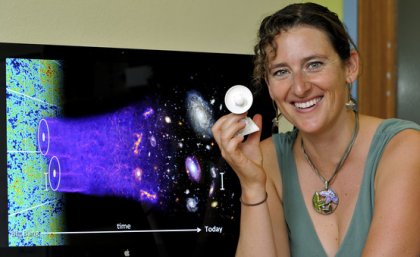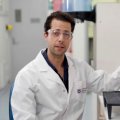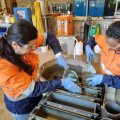
Within a few decades, astronomers will become “know-it-alls”. Literally.
In that time frame, it will be possible to see almost everything in the Universe that can be seen, according to astrophysicist Associate Professor Tamara Davis of The University of Queensland.
“But there is a ‘cosmic horizon’, a physical limit to what we can see,” she said.
Dr Davis leads the “Dark Universe” theme of the Australian Research Council Centre of Excellence for All-sky Astrophysics.
She will speak about the limits of the observable Universe at ‘The Edges of Astronomy’ conference being run by the Australian Academy of Science at the Shine Dome in Canberra today and tomorrow.
“The next few generations of telescopes will be able to survey almost the entire volume of the Universe, in all directions, all the way back to almost the beginning of time,” Dr Davis said.
“For the first time, the limit of our knowledge will be dictated by the physics of the Universe itself, rather than the capabilities of our instruments.”
However, Dr Davis adds, even if astronomers can see things happening, “that doesn’t mean that we understand them”.
“For instance, we can see galaxies forming, but we still don’t understand all of the laws of physics that make that happen,” she said.
Associate Professor Davis leads projects tackling two of the big unknowns in cosmology: dark matter (which holds galaxies together), and dark energy (which makes the expansion of the universe speed up).
Dr Davis is author of more than 60 publications, including two Nature papers and 10 papers with more than 100 citations, making her one of the world’s most highly cited astrophysicists, ranking in the top one per cent.
In her conference session, Dr Davis will be joined by three other astrophysicists who will discuss how far back in time we can see, the limits due to the smallest scales we can see, and the fundamental limits to knowledge.
Edges of Astronomy is the latest in the Australian Academy of Science’s Frontiers of Science series which brings the best young Australian scientists together with leaders in their fields.
This year the expert group will explore the potential economic benefits of astronomy, its technological spinoffs (such as WiFi), career development and astronomy’s impact on the public awareness of science.
Other conference highlights include:
- The role of venture capital in bringing basic research to impact, Dr Larry Marshall, Southern Cross Ventures
- Economic impacts of basic research, Dr Jenny Gordon, Productivity Commission
- From astronomy to archaeology, art history and art conservation, Dr Haida Liang, Nottingham Trent University, UK
CSIRO astronomer Dr Lisa Harvey Smith will also give a public talk on building the world’s biggest telescope.
The full program is here.
You can follow the conference by following the Academy's twitter account: @science_academy or via #AusFo2014 or via the conference live blog. You can also watch the conference via the Academy’s livestream.
The Australian Frontiers of Science symposium series is generously supported by the Theo Murphy Australia Fund, courtesy of the Royal Society in London.
Contact: Associate Professor Tamara Davis, 0432 526 989, tamarad@physics.uq.edu.au; Re conference: Bella Counihan 0419 212 219
Image: Tamara Davis ... next generation of telescopes will allow astronomers to see almost to the beginning of time
.jpg)












